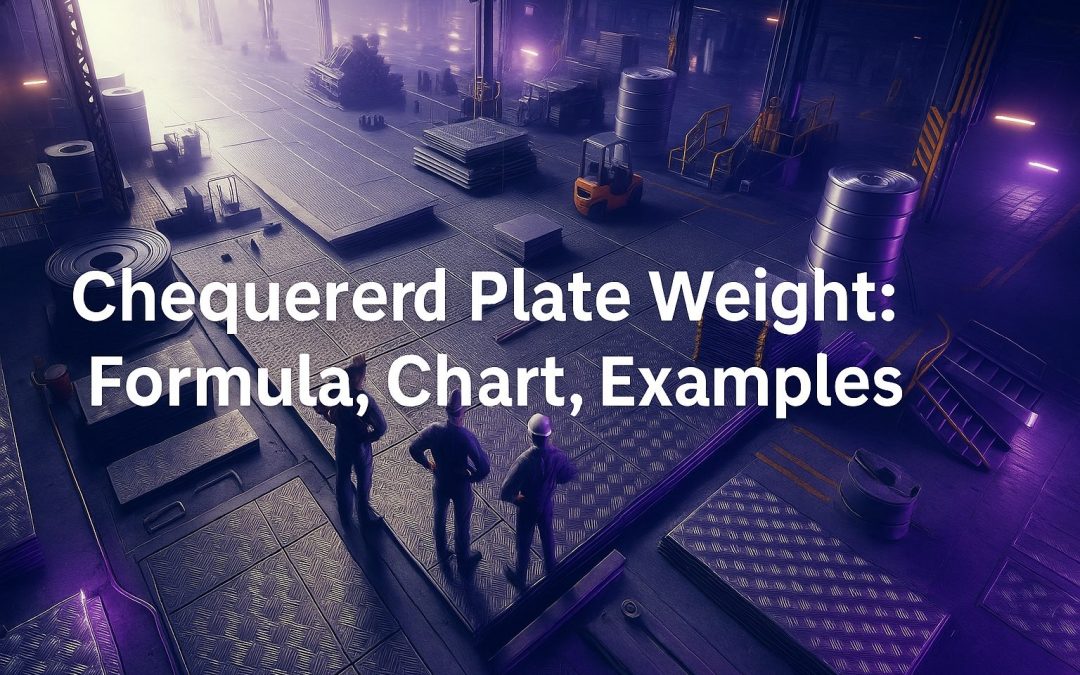Table of Contents
- An Overview
- Chequered Plates Applications
- Calculating Chequered Plate Weight
- Common Densities Table
- Pattern Adjustment (explain + methods)
- Practical Example (Weight calculation for 6mm)
- Unit Weight Calculation for Chequered Plates
- Utilising a Chequered Plate Weight Chart
- Key Considerations for Accuracy
- Procurement Checklist for Indian MSMEs
- Conclusion
- FAQs
Chequered plates, also known as tread plates, are widely used in India for flooring, walkways, truck bodies, and industrial platforms because of their slip-resistant surface and durability. These plates are primarily made from materials like mild steel, stainless steel, and carbon steel, For MSMEs involved in construction, fabrication, or transport, knowing the exact weight of these plates is more than a technical detail – it directly affects purchase cost, freight charges, handling safety, and compliance with procurement norms.
Instead of treating weight as theory, the following sections break it down in the way a procurement team would actually use it. You will see the base formula, how density affects the result, and why the raised pattern cannot be ignored in estimates. A real calculation is included so buyers can check against their own orders. There is also a reference chart and notes on what to mention in purchase orders, keeping Indian MSME requirements in view.
Applications to use Chequered plates
We previously published a comprehensive article on chequered plates. You can delve into its details to gain a thorough understanding of the topic.
To further assist you, we’ve taken specific information on applications for your understanding on the weight calculation:
- Construction: Used in stairs, walkways, ramps, and flooring to provide a non-slip surface.
- Automotive Industry: Commonly used in truck beds, ambulance floors, and vehicle steps for durability and safety.
- Industrial Flooring: Provides a strong, slip-resistant surface in factories, workshops, and warehouses.
- Decorative Purposes: Sometimes used in architecture for an industrial aesthetic.
Understanding the material and thickness of the chequered plate is crucial in selecting the right type for your specific application, ensuring both functionality and safety.
Comprehensive Guide to Calculating Chequered Plate Weight
Accurate weight calculation of chequered plates is essential, particularly in industries where the precise amount of material required can significantly impact the cost, safety, and logistics of a project. The weight of a chequered plate is determined by its volume and the density of the material used.
Formula for Weight Calculation: Weight = Volume × Density
However, due to the raised patterns on the surface, the calculation of chequered plate weight requires adjustments. Here’s a step-by-step guide:
- Measure the Dimensions:
- Length (L): Measure the length of the plate in meters.
- Width (W): Measure the width of the plate in meters.
- Thickness (T): Measure the thickness of the plate in meters (or convert from millimeters).
- Calculate the Volume:
- First, calculate the base area:
Base Area=L×W - Then, adjust for the raised pattern area. Typically, an increase of around 10% is factored in:
Adjusted Area = 1.1 × Base Area - Finally, multiply the adjusted area by the thickness to get the volume:
Volume = Adjusted Area × T
- First, calculate the base area:
- Multiply by the Material Density:
- For mild steel, the density is typically 7850 kg/m3
- The final weight calculation is: Weight = Volume × Density
Quick check:
- Convert all dimensions into metres before calculation.
- Unit weight (kg/m²) can be obtained simply as Thickness (m) × Density (kg/m³).
Common densities for plate materials
When you work out weight, the one figure that changes from material to material is density. Most buyers in India deal with mild steel, but in some cases stainless or aluminium plates are supplied. Using the wrong density will throw off your numbers and can lead to errors in transport planning or invoicing.
As a working reference:
- Mild Steel (MS): ~7,850 kg/m³ – standard choice for flooring, ramps and truck bodies.
- Stainless Steel (304 grade): ~8,000 kg/m³ – used where hygiene or corrosion resistance is required, such as food plants.
- Aluminium: ~2,700 kg/m³ – chosen when weight saving is more important than strength.
These figures are only for reference. Always check the mill test certificate (MTC) or supplier catalogue for the exact density before you finalise the purchase order.
Pattern adjustment: why it matters and how to apply it
When you calculate the weight of a plain plate, the formula is exact. With a chequered plate, the raised lugs on the surface add metal that the formula does not capture. That extra metal is small in a single sheet but can add up to several hundred kilos in a bulk order. This is why suppliers usually apply a correction factor.
In practice, mills and stockists in India often add around 5–10% to the base area to cover the pattern. The exact figure depends on the design and rolling process, so the safest option is to check the mill test certificate or product catalogue. If such data is not available, adding 10% as a working allowance is reasonable, but always note it in the purchase order to avoid disagreement when the material is weighed at delivery.
Practical Example: Weight Calculation for a 6mm Chequered Plate
Let’s apply the above method to calculate the weight of a 6mm thick mild steel chequered plate with the following dimensions:
Length: 2 meters
Width: 1 meter
Thickness: 6 millimeters (0.006 meters)
Now, here’s the stepwise calculation to follow:
- Convert Thickness to Meters
T = 6 mm = 0.006 m
- Calculate Base Area
Base Area = 2m × 1m = 2m2
- Adjust for Raised Patterns
Adjusted Area = 1.1 × 2m 2 = 2.2m2
- Calculate Volume
Volume = 2.2m2 × 0.006m = 0.0132m3
- Calculate Weight
Weight = 0.0132 m3 × 7850 kg/m3=103.62 kg
Thus, the weight of the 6mm thick mild steel chequered plate with these dimensions is approximately 103.62 kg.
Unit Weight Calculation for Chequered Plates
Understanding the unit weight of chequered plates is crucial for estimating material requirements for large-scale projects. The unit weight is the weight of the plate per square meter.
Formula for Unit Weight: Unit Weight (kg/m2) = T × Density
For a chequered plate with a 3mm thickness:
- Thickness (T): 0.003 meters
- Density of Mild Steel: 7850 kg/m3
Calculation:
Unit Weight = 0.003m × 7850 kg/m3 = 23.55 kg/m2
This unit weight is crucial for estimating the total weight of the plates required for a given area, enabling precise project planning and cost estimation.
Utilising a Chequered Plate Weight Chart
A chequered plate weight chart is an essential tool for professionals in the construction and industrial sectors. It provides a quick reference to the weights of plates with varying thicknesses, ensuring that material orders are accurate and project requirements are met efficiently.
Weight Chart (for Mild Steel Plates):
| Thickness | Width | Length | Weight |
| 3mm | 1m | 2m | 23.55 kg/m2 |
| 4mm | 1m | 2m | 31.4 kg/m2 |
| 6mm | 1m | 2m | 47.2 kg/m2 |
| 8mm | 1m | 2m | 62.8 kg/m2 |
| 10mm | 1m | 2m | 78.5 kg/m2 |
*For simplicity, we have not considered variation in area
Using this chart, you can quickly determine the weight of a plate based on its thickness and dimensions, streamlining the procurement process. It’s recommended to use the most recent chart from your steel supplier, as material specifications may vary.
Key Considerations
When calculating the weight of chequered plates, it’s important to consider several factors to ensure accuracy:
- Material Density: Different type of steel (mild steel, stainless steel, carbon steel) have different densities. Using the correct density for your material is essential for accurate calculations.
- Precision in Dimensions: Accurate measurement of length, width, and thickness is crucial. Even small errors in these measurements can lead to significant discrepancies in weight calculations.
- Adjustment for Surface Patterns: The raised patterns on chequered plates add to the overall volume and weight. Always account for this when calculating the weight, typically by adding a correction factor (e.g., 10%).
- Unit Conversions: Ensure all measurements are in uniform units (e.g., meters for length, width, and thickness) to avoid errors in calculations.
- Expert Consultation: For large or complex projects, consulting with an expert can help ensure that the right materials and calculations are used, optimizing both cost and efficiency.
Procurement checklist for Indian MSMEs
When an MSME places an order for chequered plates, most disputes arise not from price but from unclear specifications. A clear purchase order saves time at delivery and avoids arguments with the supplier or transporter.
Material and specification
- Always write the grade (for example, IS 2062 for mild steel).
- Mention thickness, width and length in full, along with tolerance limits if they matter for your use.
- State clearly if the quoted weight is gross (with pattern) or calculated on a plain plate.
Documents to collect
- Mill Test Certificate (MTC) must include chemical and mechanical properties.
- Delivery challan and packing list that shows the number of pieces and total weight.
- Invoice with GST and a correct HSN code.
Packaging and delivery
- Ask how plates will be bundled or strapped; loose loading leads to damage.
- Always double-check truck size and off-loading arrangements at your site.
- If your gate has timing restrictions or a narrow entry, note this on the PO (Purchase order).
Commercial points
- Clarify payment terms and GST applicability.
- Do fix delivery lead time and acceptance conditions. Under the MSME Act, delayed payment clauses should be recorded.
Example PO line:
“MS chequered plate IS 2062, 6 mm × 1250 mm × 2500 mm, weight as per supplier’s datasheet (pattern included), Qty 20 pcs, approx. ___ kg.”
Conclusion
Enhancing Project Efficiency with Accurate Chequered Plate Weight Calculations
Accurate chequered plate weight calculations are integral to successful project execution, particularly in construction and industrial applications. By understanding the methods and considerations involved in these calculations, professionals can ensure that they are using the right amount of material, optimizing both resources and costs. Utilize weight calculators, charts, and expert advice to enhance the precision and efficiency of your projects, ensuring they meet both safety standards and budgetary constraints.
Updated on 29 September 2025 with an objective to offer a broader introduction, emphasizing chequered plate weight calculations in project efficiency. It enhances focus on practical applications, simplifies examples for clarity, and provides practical guidance like consulting updated charts and expert advice. The conclusion reinforces the importance of accurate calculations with actionable insights.
Looking to procure steel?
Tata nexarc helps manufacturers, builders and MSMEs source certified steel products, compare prices, and choose the right grade as per IS codes—with complete traceability and procurement confidence.
FAQs
How much heavier is a chequered plate than a plain plate of the same thickness?
Which density should I use for mild steel vs stainless?
How do I convert mm thickness to unit weight (kg/m²)?
What tolerance should I specify in the PO?
How to plan transport – what weight thresholds matter?
Can I use the unit weight table to estimate freight cost?
What documents should I insist on from the supplier?
If a plate is galvanised or painted, how does that affect weight?
Sohini is a seasoned content writer with 12 years’ experience in developing marketing and business content across multiple formats. At Tata nexarc, she leverages her skills in crafting curated content on the Indian MSME sector, steel procurement, and logistics. In her personal time, she enjoys reading fiction and being up-to-date on trends in digital marketing and the Indian business ecosystem.








This guide’s a lifesaver for steel project budgeting! Forget complex formulas – the weight chart for MS chequered plates is gold. Lets me pick the right amount of material and avoid overspending. Especially helpful for quick quotes! Thanks!
The post provides a very clear and helpful explanation of calculating chequered plate weight. Also specifies the areas of possible errror. It will help me in quickly calculating the weight of the loads for transportation.
hello sir,please tell me what kg/m² of 12mm MS chequered plate?
Weight Kg/M = 94.2
Width Kg/M =226
The weight chart provided in the blog is really helpful. I have been able to easily determine the total weight of the required load of chequered plate for my construction project.
The weight information for MS chequered plates is helpful. Please add some more information around vendors in Muradabad UP